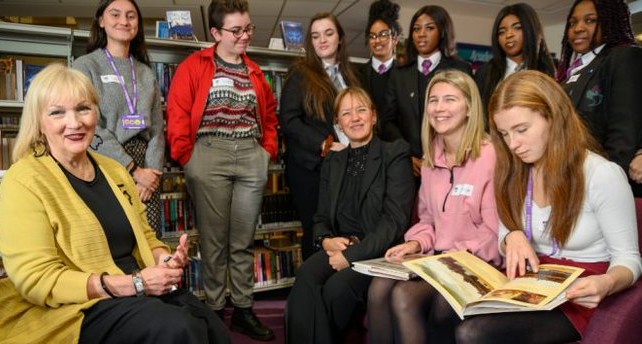Call free on: 0800 389 2839
Call free on: 0800 389 2839
Join in... The latest news and blogs from NEC
Guest article: “An A level in art history can open up many possibilities” Thursday, 12 December 2019

No-one ever told me that there was a subject called ‘art history’ when I was at my school in Yorkshire, I had to wait until I discovered it at University. I changed my degree choice from English to the subject that I have had the joy of teaching and researching for the last 25 years – I am now a Professor of Art History. The launch of the new A level History of Art, making it available for the first time for students in the North of England, hopefully means others will not have to wait as long as me to find out about the importance and validity of this subject or discover it by mistake…
At a time when the creative industries are the fastest growing sector in the UK, bringing in billions of pounds to our economy, and the envy of the world, we need to make subjects available to students in the North that open up the possibility of working in this sector, and art history does this. Consider, for example, how many museum and gallery collections we have in the UK and the fact that Tate Modern and the British Museum are the most visited collections in the world. Who works there and how did they become curators, educators, collections managers etc.? The majority studied art history. Across the globe, countries like China, the United Arab Emirates and Qatar are investing in huge museum and gallery projects, and we are training the next generation of staff at UK universities. The art market is centred on the UK, and contemporary art sales are increasing every year so we need auctioneers and experts. My graduates are journalists, lawyers, architects, work in PR and education, have won Baftas, been nominated for Oscar’s and the Turner Prize. Many barristers have arts degrees, because art history teaches you to look carefully, be curious, critically analyse and present your findings in a confident and compelling way. Students applying to medical school are often encouraged to add art history into their A level mix as it teaches them to look critically, and also introduces them to how the body has been understood in the past in a way that helps them consider the possibilities for the future. In a world that increasingly communicates visually – think Snapchat, Instagram and the challenge of fake news and doctored photos – we need art historians to interpret the world, to understand the past and look to the future. And jobs in this area are well protected from the potential for automation.
A bright future needs graduates from a diverse mix of backgrounds, who have a clear understanding of their place in the world and the contribution they can make.
When I introduce my subject, I often use the example of James Dyson, taught by the first Professor of Art at Leeds, who, when faced with a machine to clean carpets, approached it creatively, and created a billion pound business. Or Jony Ives, the British designer who, on meeting Steve Jobs, changed a failing tech business into the global success story that is Apple.
An A level in art history can open up many possibilities and enable students to think differently about the past. Using history, philosophy, sociology, literature, religious studies, economics etc. can help them understand why artists made art that reflected their world but also hoped to change the world. I recommend everyone thinks about the possibilities that might come from studying this incredible subject.
Professor Abigail Harrison Moore is Professor of Art History and Museum Studies at the School of Fine Art, History of Art and Cultural Studies at University of Leeds.
Add a new comment
Current comments: 1
Leave a Reply Cancel reply
More stories
working at NEC
Uncategorized
- Balancing an A level with My Passion for Dance
- The Future of Art History: Why Study A level History of Art with the National Extension College?
- Why Study Physics?
- Embracing a New Path: Jill’s Journey from Online Learning to Career Success in Art History
- How Toby Found a Perfect Fit for His Passion: Online A level English Literature with NEC
Study Tips
Student Stories
- Balancing an A level with My Passion for Dance
- Passion and Academics: How Izzy Balances Full-time Musical Theatre Studies with Studying A level Physics
- How NEC Helped Kari’s Son Niko to Continue his A level Studies Despite Long-Term Illness
- Embracing a New Path: Jill’s Journey from Online Learning to Career Success in Art History
- How Toby Found a Perfect Fit for His Passion: Online A level English Literature with NEC
SFT
Results Day
- Resitting A level STEM Subjects: How to Turn Your Setback into a Stepping Stone for a Brighter Future
- Resits vs. Retakes: Understanding the Difference and Making the Most of Your Second Chance
- GCSE Results Day 2024: What to Do When You Didn’t Get the GCSE Results You Wanted
- GCSE Results Day 2024: Your Complete Guide
- A level Results Day 2024: Your Ultimate Guide to Success
Policy and Campaigns
- A Pathway to Success Beyond A levels: Why Level 4 and Level 5 Qualifications Matter
- Schools and Academies Show 2024: Insights for School Leaders
- Big Data and Educational Trends: Insights for Students and Schools
- University of Cambridge Institute of Continuing Education offers tuition fee bursary for NEC A level students
- Five study bursaries for state sector teachers to take online A level Classical Civilisation offered by The Classical Association
Podcast
Our Courses
- Balancing an A level with My Passion for Dance
- How NEC’s Inclusive Approach to Learning Design is Redefining Independent Learning
- NEC’s Learning Design: A Pathway to Success for Independent Learners
- Passion and Academics: How Izzy Balances Full-time Musical Theatre Studies with Studying A level Physics
- Why Study Psychology? – Key Benefits, Careers and What You’ll Need to Study Psychology at University
Lifelong Learning
- A Pathway to Success Beyond A levels: Why Level 4 and Level 5 Qualifications Matter
- Benefits of Homeschooling: Is Home Education Right for Your Family?
- How NEC’s Inclusive Approach to Learning Design is Redefining Independent Learning
- The Future of Art History: Why Study A level History of Art with the National Extension College?
- National Coding Week 2024: The Vital Role of Coding in the Modern World
Home Schooling
- Benefits of Homeschooling: Is Home Education Right for Your Family?
- How NEC Helped Kari’s Son Niko to Continue his A level Studies Despite Long-Term Illness
- Exploring Science Practicals at Home: A Guide for Homeschoolers
- Homeschooling in 2024: How to Personalise Your Child’s Education
- What is Homeschooling?
Guest Blogs
- Passion and Academics: How Izzy Balances Full-time Musical Theatre Studies with Studying A level Physics
- My Experience as a Marketing Intern with the National Extension College
- The economics of political parties
- Embarking on a journey: My decision to ‘Fast-Track’ A level Physics with NEC
- Homeschooler Andrew’s experience of studying IGCSE Chemistry
General
- Balancing an A level with My Passion for Dance
- A Pathway to Success Beyond A levels: Why Level 4 and Level 5 Qualifications Matter
- Schools and Academies Show 2024: Insights for School Leaders
- How NEC’s Inclusive Approach to Learning Design is Redefining Independent Learning
- NEC’s Learning Design: A Pathway to Success for Independent Learners

One Comment